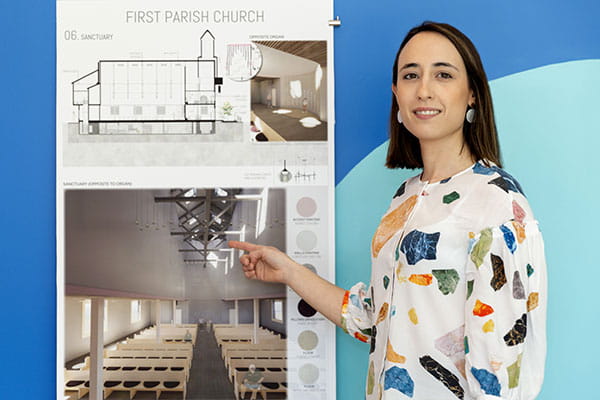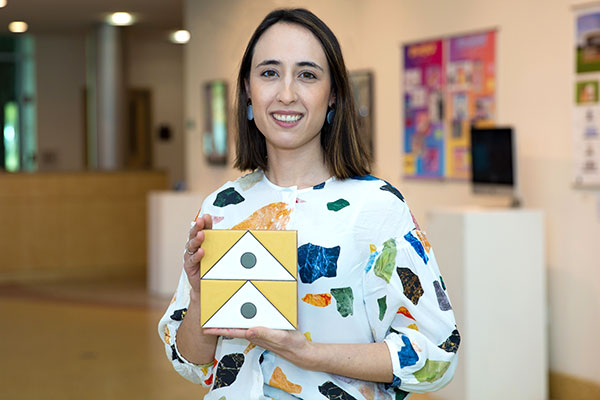A civil engineer by training, Isaura Sagredo M’23 previously worked in Qatar’s futuristic capital city of Doha as a Lead Project Engineer, helping to plan the construction of the driverless metro rail system that ultimately transported three million spectators to the soccer stadium during the FIFA World Cup Qatar 2022.
Sagredo was so entranced by the innovative ways that traditional Qatari design elements were incorporated into the 37 stations’ vaulted interiors, that she decided to switch tracks herself and become an interior architect.
Nowadays, she spends early weekday mornings on a different metro system altogether. As a graduate student in Endicott’s Interior Architecture Master’s Degree Program Career Changer Track, Sagredo commutes to the Nest from the apartment she shares with her partner in Boston’s West End neighborhood.
If you’re an early riser, you’ve probably seen her fly by on the scooter she carries onto the train and then unfolds at the Beverly Depot station, zipping to the Walter J. Manninen Center for the Arts atrium for a morning class. She loves the feeling of the wind flipping through her hair and ordering a coffee from EAT Café’s friendly barista, Nancy.
“Some of my biggest ideas came from that atrium,” said Sagredo. “I’ll always remember getting there so early it was still empty, looking out all those windows at the lake and feeling connected to nature as I sat with my laptop and prepared for class.”
Sagredo, who grew up in a Spanish village and is influenced by European design as a result, said, “What excites me is creating a connection between a space and its user, integrating daylight and natural ventilation, and designing to make a positive impact on the environment.”
The atrium, with its soft morning light and three-story tall glass windows, helped her to think through a meaningful project transforming First Parish Unitarian Universalist Church in downtown Beverly into a space that can serve as temporary shelter to unhoused individuals at night. During her Advanced Spatial Design Studio, Sagredo and her cohort were assigned their first adaptive reuse project and they were tasked with giving another use to this existing building.

The goal was to maintain the active church facilities while creating overnight space for the homeless and a community café for everyone to share. Sagredo spent time listening to the client and walking through the magnificent 17th-century sanctuary.
The obvious space to fit the beds was in the windowless basement, but she felt strongly that hiding them wasn’t a solution.
“Dignity is very important. We are all human and have to be connected with natural light and know if it’s morning or afternoon in your living space,” Sagredo said.
Instead, she used the church’s antique organ as a starting point, taking the musical notes that ring from it as design inspiration, and locating the shelter space in a new mezzanine area right above. There, guests could benefit from arched windows and tune back into their circadian rhythms.
Downstairs in the church, Sagredo added acoustic wood panels, a striking light fixture, and durable carpeting referencing organ keys, all of which incorporate musical algorithms and patterns. The theme reinforces the idea that this is “a community space where all individuals are welcomed to create melody together,” she said.
This belief in community anchors Sagredo’s thoughtful practice.
“Working in such a multicultural environment in Doha, I learned that everyone has a valid opinion and mine isn’t the only one that matters,” she said. “It’s the interaction of ideas and collaboration that really moves my work along in interior architecture too.”

At Endicott, Sagredo picked up the tools needed to channel principles and thoughts into design concepts—from bubble diagrams and block diagrams to floor plans and 3D renderings. It all began with a pivotal first studio class taught by her advisor and Director of Interior Architecture Programs Myoung Joo Chun.
“Whenever I feel lost, I remember what I learned in that class,” Sagredo said. “The biggest thing is that we don’t just design something to be beautiful. We design for a purpose and to make a positive impact.”
When it comes to her graduate thesis, Sagredo’s purpose is clear. Her work investigates how design can enhance adolescent cancer patients’ recovery experiences and infuse a quality of hope, foster peer group support, and transform outpatient environments into healing spaces.
Now, Sagredo has begun her post-graduation job search. She’s committed to remaining in the Boston area and working for a commercial or residential firm, ideally one that designs for communities around the world—on a budget or for a cause.
“You don't need a lot of money for clever design,” she said. “Sometimes you just need to think in different ways and bring in different perspectives.”


